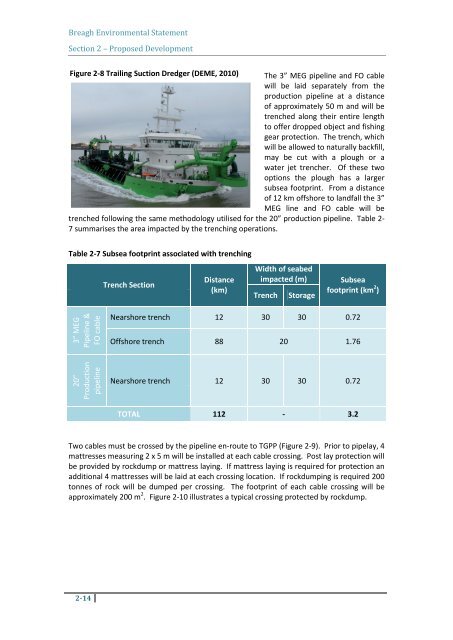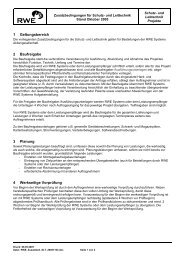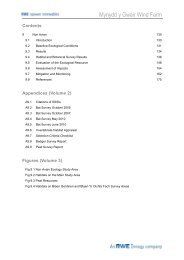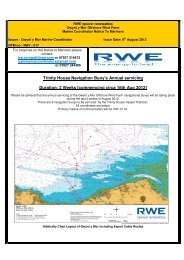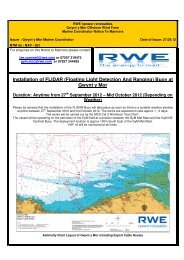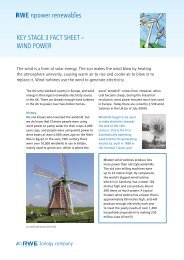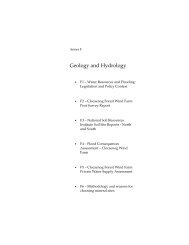- Page 1 and 2: Breagh Development Phase I Environm
- Page 3 and 4: Breagh Environmental Statement Non
- Page 5 and 6: Breagh Environmental Statement Non
- Page 7 and 8: Breagh Environmental Statement Non
- Page 9 and 10: Breagh Environmental Statement Non
- Page 11 and 12: Breagh Environmental Statement Non
- Page 13 and 14: Breagh Environmental Statement Non
- Page 15 and 16: Breagh Environmental Statement Non
- Page 17 and 18: Breagh Environmental Statement Non
- Page 19 and 20: 1. Introduction Breagh Environmenta
- Page 21 and 22: 1.4. Scope of the Environmental Sta
- Page 23 and 24: Breagh Environmental Statement Sect
- Page 25 and 26: Breagh Environmental Statement Sect
- Page 27 and 28: 2. Proposed Development 2.1. Introd
- Page 29 and 30: Figure 2-2 Breagh reservoir depth m
- Page 31 and 32: Figure 2-3 Breagh Export Route Opti
- Page 33 and 34: Breagh Environmental Statement Sect
- Page 35 and 36: Breagh Environmental Statement Sect
- Page 37 and 38: Breagh Environmental Statement Sect
- Page 39: Discharges Overboard Breagh Environ
- Page 43 and 44: • Survey vessel (pre and post lay
- Page 45 and 46: The shallow water section of the pi
- Page 47 and 48: Breagh Environmental Statement Sect
- Page 49 and 50: Figure 2-15 Schematic of a generic
- Page 51 and 52: Breagh Environmental Statement Sect
- Page 53 and 54: Solid wastes from drilling Breagh E
- Page 55 and 56: 2.8. Production Breagh Environmenta
- Page 57 and 58: Breagh Environmental Statement Sect
- Page 59 and 60: 2.10. Permits and Consents Breagh E
- Page 61 and 62: Re-use in situ Breagh Environmental
- Page 63 and 64: NUI removal Breagh Environmental St
- Page 65 and 66: Breagh Environmental Statement Sect
- Page 67 and 68: Breagh Environmental Statement Sect
- Page 69 and 70: Breagh Environmental Statement Sect
- Page 71 and 72: Breagh Environmental Statement Sect
- Page 73 and 74: Breagh Environmental Statement Sect
- Page 75 and 76: Breagh Environmental Statement Sect
- Page 77 and 78: Breagh Environmental Statement Sect
- Page 79 and 80: Breagh Environmental Statement Sect
- Page 81 and 82: Breagh Environmental Statement Sect
- Page 83 and 84: Breagh Environmental Statement Sect
- Page 85 and 86: Breagh Environmental Statement Sect
- Page 87 and 88: Breagh Environmental Statement Sect
- Page 89 and 90: Breagh Environmental Statement Sect
- Page 91 and 92:
Breagh Environmental Statement Sect
- Page 93 and 94:
Breagh Environmental Statement Sect
- Page 95 and 96:
Breagh Environmental Statement Sect
- Page 97 and 98:
Breagh Environmental Statement Sect
- Page 99 and 100:
Breagh Environmental Statement Sect
- Page 101 and 102:
Breagh Environmental Statement Sect
- Page 103 and 104:
Breagh Environmental Statement Sect
- Page 105 and 106:
Breagh Environmental Statement Sect
- Page 107 and 108:
Breagh Environmental Statement Sect
- Page 109 and 110:
Breagh Environmental Statement Sect
- Page 111 and 112:
Breagh Environmental Statement Sect
- Page 113 and 114:
Breagh Environmental Statement Sect
- Page 115 and 116:
Breagh Environmental Statement Sect
- Page 117 and 118:
Breagh Environmental Statement Sect
- Page 119 and 120:
Breagh Environmental Statement Sect
- Page 121 and 122:
Breagh Environmental Statement Sect
- Page 123 and 124:
Breagh Environmental Statement Sect
- Page 125 and 126:
Breagh Environmental Statement Sect
- Page 127 and 128:
4. Environmental Assessment Methodo
- Page 129 and 130:
5. Assessment of Potential Impacts
- Page 131 and 132:
Breagh Environmental Statement Sect
- Page 133 and 134:
5.2 Drilling Phase 5.2.1. Atmospher
- Page 135 and 136:
Breagh Environmental Statement Sect
- Page 137 and 138:
Breagh Environmental Statement Sect
- Page 139 and 140:
Breagh Environmental Statement Sect
- Page 141 and 142:
Breagh Environmental Statement Sect
- Page 143 and 144:
3” pipeline 20” pipeline Table
- Page 145 and 146:
Breagh Environmental Statement Sect
- Page 147 and 148:
Breagh Environmental Statement Sect
- Page 149 and 150:
Breagh Environmental Statement Sect
- Page 151 and 152:
Figure 5-4 Recorded vessel trajecto
- Page 153 and 154:
Breagh Environmental Statement Sect
- Page 155 and 156:
Breagh Environmental Statement Sect
- Page 157 and 158:
Breagh Environmental Statement Sect
- Page 159 and 160:
Breagh Environmental Statement Sect
- Page 161 and 162:
6. Conclusions Breagh Environmental
- Page 163 and 164:
Breagh Environmental Statement Sect
- Page 165 and 166:
Breagh Environmental Statement Sect
- Page 167 and 168:
Breagh Environmental Statement Sect
- Page 169 and 170:
Breagh Environmental Statement Sect
- Page 171 and 172:
Appendix A - Register of Environmen
- Page 173 and 174:
Field Development Plan Pipeline Wor
- Page 175 and 176:
Location of structures Well consent
- Page 177 and 178:
deposits of the seabed Fisheries li
- Page 179 and 180:
Installation including Pipelay and
- Page 181 and 182:
Hazardous and non-hazardous drainag
- Page 183 and 184:
Flaring and Venting Nearshore Disch
- Page 185 and 186:
Decommissioning Issue Legislation R
- Page 187 and 188:
Wildlife Protection Issue Legislati
- Page 189 and 190:
Chemicals Proposed EU instruments o
- Page 191 and 192:
B. Environmental Assessment Potenti
- Page 193 and 194:
Noise Physical presence of installa
- Page 195 and 196:
Environmental Aspect Source Activit
- Page 197 and 198:
Drain water Food wastes from rig an
- Page 199 and 200:
Physical presence Noise Physical pr
- Page 201 and 202:
Environmental Aspect Source Activit
- Page 203 and 204:
Disposal to Land Discharge of hydro
- Page 205 and 206:
Physical presence of pipelay vessel
- Page 207 and 208:
Physical presence of rockdump and m
- Page 209 and 210:
Visual Impacts Accidental Event Pip
- Page 211 and 212:
Discharges to sea Sewage from NUI d
- Page 213 and 214:
Physical Presence Physical presence
- Page 215 and 216:
Production Phase 5 1 Low area. Deco
- Page 217 and 218:
Breagh Environmental Statement Appe
- Page 219 and 220:
Breagh Environmental Statement Appe
- Page 221 and 222:
Breagh Environmental Statement Appe
- Page 223 and 224:
Breagh Environmental Statement Appe
- Page 225 and 226:
Breagh Environmental Statement Appe
- Page 227 and 228:
D. Environmental Management D.1. Ma
- Page 229 and 230:
Figure D - 2 RWE HS&E Policy Statem
- Page 231 and 232:
Breagh Environmental Statement Appe
- Page 233 and 234:
Breagh Environmental Statement Appe
- Page 235 and 236:
Breagh Environmental Statement Appe
- Page 237 and 238:
Breagh Environmental Statement Appe
- Page 239 and 240:
Breagh Environmental Statement Appe
- Page 241 and 242:
Breagh Environmental Statement Appe
- Page 243 and 244:
Breagh Environmental Statement Appe
- Page 245 and 246:
Breagh Environmental Statement Appe
- Page 247 and 248:
Breagh Environmental Statement Appe
- Page 249 and 250:
Breagh Environmental Statement Appe
- Page 251 and 252:
Breagh Environmental Statement Appe
- Page 253 and 254:
Breagh Environmental Statement Appe
- Page 255 and 256:
Breagh Environmental Statement Appe
- Page 257 and 258:
Breagh Environmental Statement Appe
- Page 259 and 260:
Breagh Environmental Statement Appe
- Page 261 and 262:
Breagh Environmental Statement Appe
- Page 263 and 264:
Breagh Environmental Statement Appe
- Page 265 and 266:
Breagh Environmental Statement Appe
- Page 267 and 268:
Breagh Environmental Statement Appe
- Page 269 and 270:
Breagh Environmental Statement Appe
- Page 271 and 272:
Breagh Environmental Statement Appe
- Page 273 and 274:
Breagh Environmental Statement Appe
- Page 275 and 276:
Breagh Environmental Statement Appe
- Page 277 and 278:
Breagh Environmental Statement Appe
- Page 279 and 280:
G. Drawings Breagh Environmental St
- Page 281 and 282:
Figure E 14 Bathymetry along the pr


